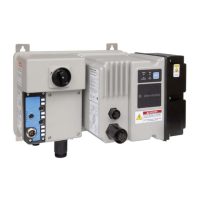Rockwell Automation Publication 2080-UM002N-EN-E - November 2022 33
Chapter 2 About Your Controller
The following considerations determine whether the power source must be required to supply
high inrush current:
• The power-up sequence of devices in a system.
• The amount of the power source voltage sag if the inrush current cannot be supplied.
• The effect of voltage sag on other equipment in the system.
If the entire system is powered-up at the same time, a brief sag in the power source voltage
typically will not affect any equipment.
Loss of Power Source
The optional Micro800 AC power supply is designed to withstand brief power losses without
affecting the operation of the system. The time the system is operational during power loss is
called program scan hold-up time after loss of power. The duration of the power supply hold-
up time depends on power consumption of controller system, but is typically between 10
milliseconds and 3 seconds.
Input States on Power Down
The power supply hold-up time as described above is generally longer than the turn-on and
turn-off times of the inputs. Because of this, the input state change from “On” to “Off” that
occurs when power is removed may be recorded by the controller before the power supply
shuts down the system. Understanding this concept is important. The user program should be
written to take this effect into account.
Other Types of Line Conditions
Occasionally the power source to the system can be temporarily interrupted. It is also possible
that the voltage level may drop substantially below the normal line voltage range for a period
of time. Both of these conditions are considered to be a loss of power for the system.
Preventing Excessive Heat For most applications, normal convective cooling keeps the controller within the specified
operating range. Ensure that the specified temperature range is maintained. Proper spacing
of components within an enclosure is usually sufficient for heat dissipation.
In some applications, a substantial amount of heat is produced by other equipment inside or
outside the enclosure. In this case, place blower fans inside the enclosure to assist in air
circulation and to reduce “hot spots” near the controller.
Additional cooling provisions might be necessary when high ambient temperatures are
encountered.
Master Control Relay A hard-wired master control relay (MCR) provides a reliable means for emergency machine
shutdown. Since the master control relay allows the placement of several emergency-stop
switches in different locations, its installation is important from a safety standpoint.
Overtravel limit switches or mushroom-head push buttons are wired in series so that when
any of them opens, the master control relay is de-energized. This removes power to input and
output device circuits. See Figure 1 on page 35
and Figure 2 on page 36.
Do not bring in unfiltered outside air. Place the controller in an enclosure
to protect it from a corrosive atmosphere. Harmful contaminants or dirt
could cause improper operation or damage to components. In extreme
cases, you may need to use air conditioning to protect against heat
build-up within the enclosure.

